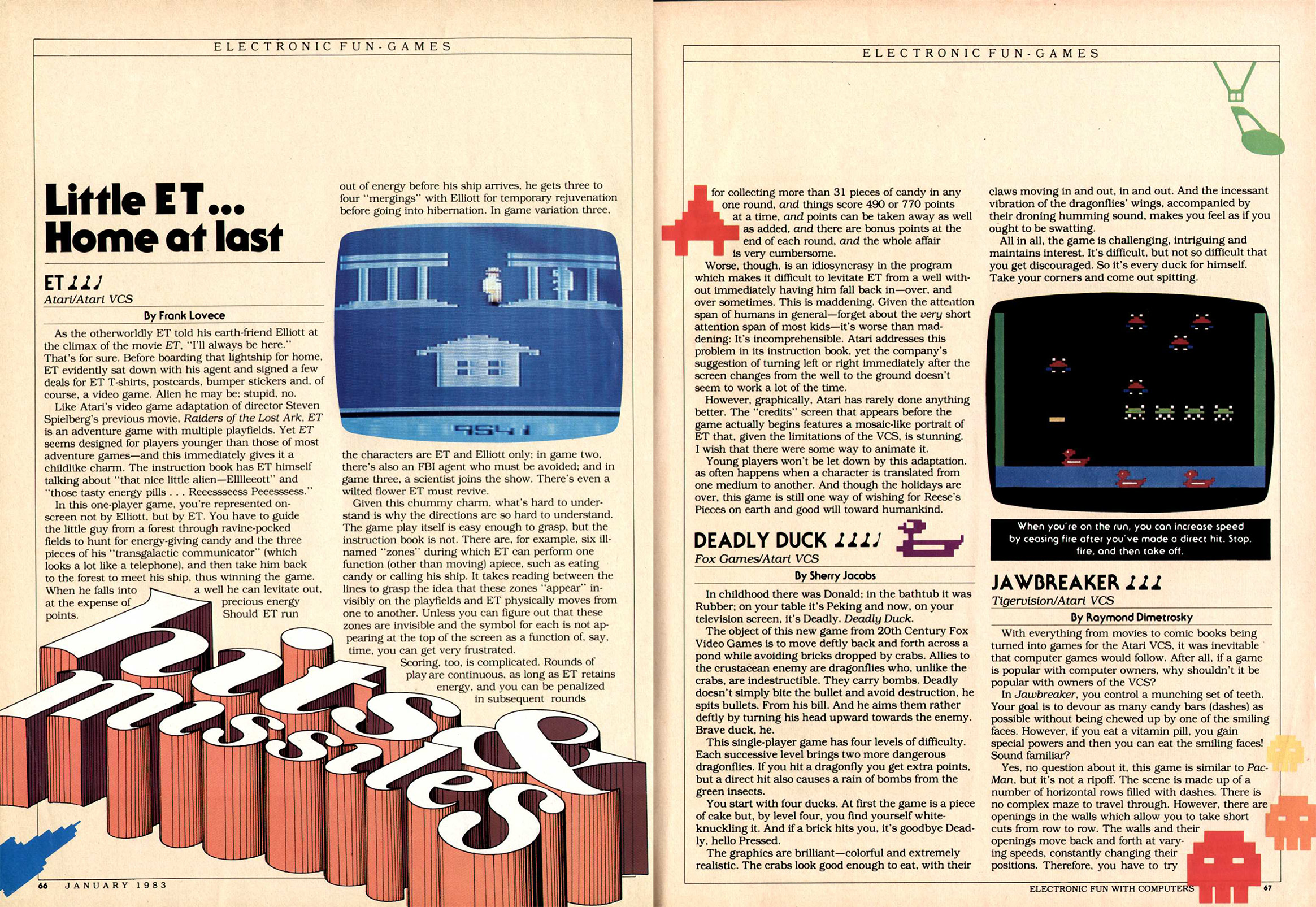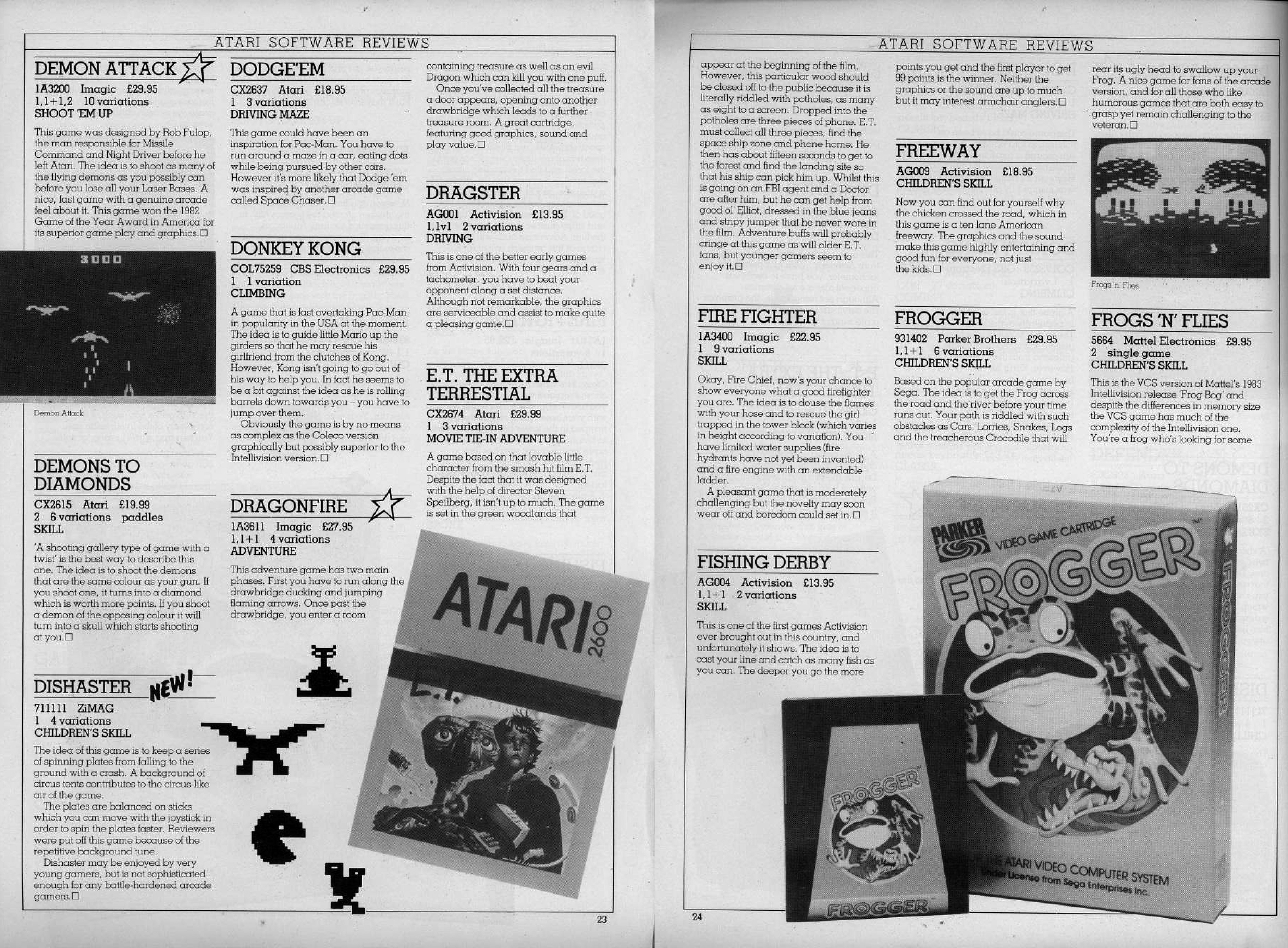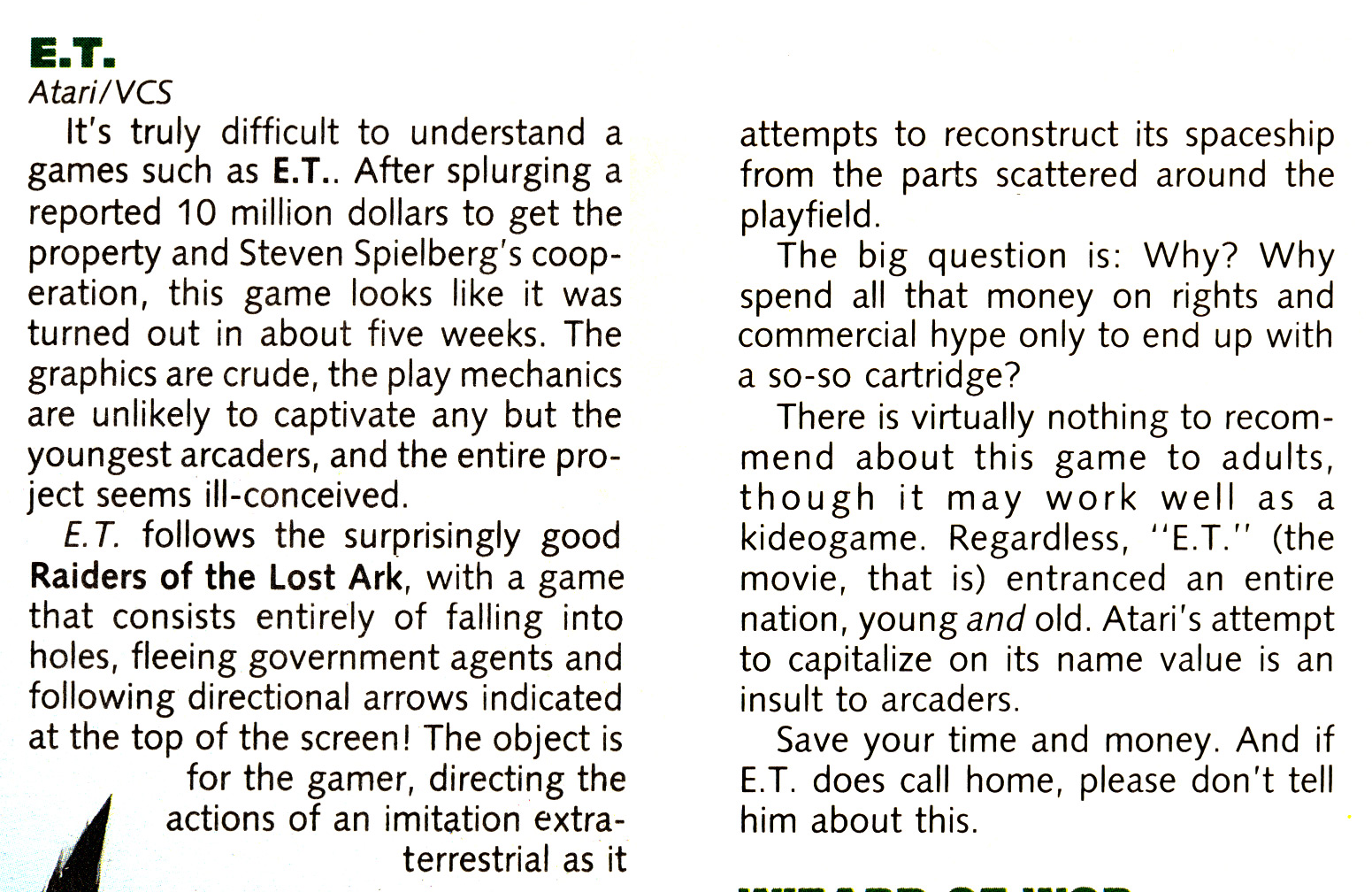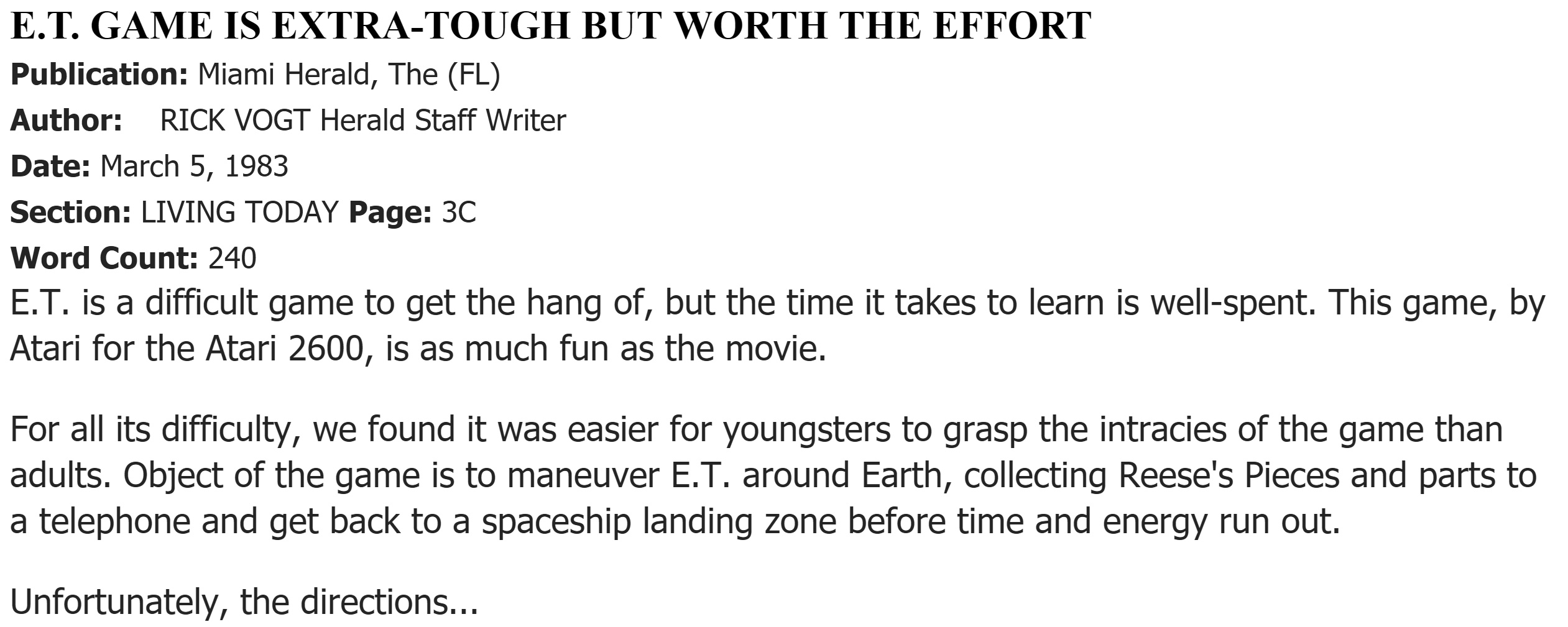E.T. the Extra-Terrestrial, the movie, is one of the highest-grossing films of all time. It’s a beloved motion picture that cemented the role of the blockbuster in modern cinema even to the present day.
E.T. the Extra-Terrestrial, the video game, has often been called — at least in recent years — one of the worst video games ever made.
There is some justice to this (the game definitely has its flaws), but it is likely that the extremity of current opinions, sometimes possessed even by people who’ve never played the game, is the result of a piling-on of recent bad reviews, especially some by gaming websites and on YouTube.

E.T. also has a certain cultural stigma because of a couple of long-standing urban legends surrounding it. The first is that Atari, expecting huge sales, greatly overproduced E.T. carts, leaving them with huge amounts of unsold and returned inventory that was buried in a landfill in New Mexico. The landfill was real, yes, but a 2015 excavation of the site revealed that E.T. cartridges represented only a portion of the nearly 800,000 games buried there.
The second urban legend is that E.T. sold so badly that the game was a direct cause of the video game market crash of 1983, the near-complete destruction of the American video game industry. Could one game cause that? Absolutely not. E.T. wasn’t a cause of the video game crash, it was a symptom of the problems that caused it.
Regardless, Atari had high hopes for the game, which — along with another movie tie-in, Raiders of the Lost Ark — was its great hope for what turned out to be a 1982 Christmas sales season so disappointing that it sent stocks plummeting and executives packing.
But was it because nobody liked the game? What did critics in 1982 actually think about E.T.?
The Reviews
We dug up nine significant reviews of E.T. the Extra-Terrestrial from the period surrounding its release to find out what critical consensus was at the time, and to see what its average review score might look like if these reviews were published today.
We rated each review’s opinion on a scale from Greatly Negative to Greatly Positive. The General Reaction score at the end is an average of these scores. In modern terms, Greatly Negative might be considered like a score of 30/100, and Greatly Positive like a score of 90/100.
Chicago Tribune, November 19, 1982

Author Clarence Petersen could not figure the game out, writing: “The new Atari home video game based on the movie ‘E.T. The Extra-Terrestrial’ is a genuine mindbender. In three hours of play, not once could I return E.T. to the landing site, let alone get him safely abord the lightship before his time ran out and the poor thing lay dead on the color TV screen.”
That, despite the assistance of the game’s instructions and a teenage player generally expert at video games. Atari insisted to writer Clarence Petersen that seven-year-olds had been able to figure it out.
Assessment: Greatly Negative
Arcade Express, December 5, 1982

That the game was hurried through development was no secret (the movie had been released three months before the game), and the review takes it to task for being a rush job, but admits kids may like it. “While it is hard to deny this cartridge’s obvious shortcomings, ‘E.T.’ should perhaps be judged as an attempt to produce an action-tinged adventure game for the younger home arcader.”
Assessment: Slightly Positive
Electronic Fun With Computers & Games, January 1983

Frank Lovece rates it 2 1/2 “joysticks” out of 4. Atari 2600 Gorf, from the same issue, got 2 joysticks. Ladybug for ColecoVision, an awesome port, got the full 4. The review cites the problems with the manual, in which necessary information, the nature of the “zones,” is badly explained. It’s a good review.
Assessment: Slightly Positive
TV Gamer Magazine, January 1983

“Despite the fact that it was designed with the help of director Steven Spielberg, it isn’t up to much,” although “younger gamers seem to enjoy it.”
Assessment: Slightly Positive
Electronic Games, April 1983

This may have been written by the same person who wrote the Arcade Express review, as that newsletter was part of the Electronic Games family, but is rather more negative. “The graphics are crude, the play mechanics are unlikely to captivate any but the youngest arcaders, and the entire project seems ill-conceived.”
Assessment: Negative
Joystik, April 1983

Rated 2/4 stars. “To paraphrase a line from the movie, E.T. is nothing to phone home about.” The review also notes the game seems made for kids, claiming it’s “a *very* cute game.” Notably, the review finishes with these words: “[…]in the next few months it will be *impossible* to avoid this game. In addition to its 2600 version, Atari is also planning E.T. games for the 5200 system, 400/800 computers, and arcades.” While an unrelated E.T. game eventually made its way to Atari’s home computers, the 5200 and arcade versions never materialized.
Assessment: Neutral
Vidiot, February/March 1983

Not so much a review as a feature article. The article calls it an A-1 game with only one flaw: falling into the pits. It also mentions they got a preview package from Atari, which might have played a role in inspiring the writer to such superlatives (not to mention that E.T.’s face graces both the cover and a fold-out poster inside…).
Assessment: Greatly Positive
Miami Herald, March 5, 1983

“E.T. is a difficult game to get the hang of, but the time it takes to learn is well-spent. This game, by Atari for the Atari 2600, is as much fun as the movie.” Testers for the Herald all complained about the instructions and the pits, but once they got past that tended to enjoy the game. “Many testers disliked the difficulty in learning the game, though they agreed it was one of the better video games they have played.” The article recommends starting with Game Variation 3, the “Children’s Game.”
Assessment: Positive
The Video Game Update, January 1983

“This is not nearly as involved as adventure games such as RAIDERS OF THE LOST ARK or SWORDQUEST EARTHWORLD, but it’s an enjoyable quest nonetheless.”
Assessment: Positive
The Final Score: 67 (Neutral)
The effective metascore works out to be 67, which can arguably be rounded up to Slightly Positive at 70. If we take out Vidiot’s very positive feature-length review, the average works out to 64, rounding down to Neutral.
Analysis
Three major issues are identified by the reviews:
- The game’s “crude graphics.” Many people (myself included) don’t think the game looks any worse than the other VCS games of the era. What issues there are, if indeed there are any, could be laid at the feet of the game’s short development time.
- The pits. It’s very easy for E.T. to fall into a pit. Some pits cover the edge of the screen, and result in a sudden damaging fall if you just walk off screen the wrong way. Other pits, once you levitate out of them, if you aren’t careful you might just fall right in again. This is arguably the game’s greatest flaw, and can be immensely frustrating to overcome until the player discovers the knack to avoiding off-screen pits.
- The instructions. Read them for yourself here. While not part of the game itself, the instructions were an integral part of the game experience from that time. Without much ROM space to spare for tutorials or text, players relied on the included booklet to discover how to play.
To select between E.T.’s powers requires being in the right “power zone” in the game worked, identified by an on-screen icon. Depending on your power zone, the purpose of the controller’s single button changed, between eating candy for energy, to sending humans back to their base, to searching out phone pieces, to calling Elliot for help.
One zone in particular is used to call home and initiate the endgame. This is all essential information laid out in the rulebook, but it might be a bit unexpected to a player expecting a simple game. The odd thing is, most reviewers claimed that E.T. was specifically *for* kids, which is at odds with all the icons and special powers players had to memorize — the locations of which were randomized for each game!
Atari games, additionally, included multiple game variations, and they were all documented in the book. E.T. contained a “Children’s Game,” a common feature of Atari VCS games, a special game variation marked with a teddy-bear icon with reduced difficulty for children to play.

Conclusion
E.T. was far from the “worst game ever” at the time of its release. In fact, it wasn’t even the worst game reviewed on the system that month: Gorf tended to get slightly worse reviews. I think it goes to show how later public perception of a game, especially when the game becomes the subject of website and YouTube derision can become magnified over time and result in a pile-on.
E.T. may not be the “worst game ever,” but with its high licensing cost and failure to perform at the market, it was an easy scapegoat for a console game industry in decline.
While E.T. is fairly mediocre, it does hold an important place in the history of game design. Like Atari’s earlier Adventure and Superman, players can explore and travel around the game’s world at their own pace. There is no overall time limit, or pressure driving the game, and events like human attacks can take place at their own initiative, from outside of the player’s immediate surroundings.
Its exploratory design is a very simple and crude version of today’s open world games like Grand Theft Auto and Zelda: Breath of the Wild. To simply mock it is to deprive one’s self a view of the unique triumphs of early game development: to make an engaging experience under dire hardware constraints, to create a game world with a tiny amount of program space to work with, to get players to perceive the wonders of a cinematic triumph in the form of simple blocky graphics and approaching footsteps.